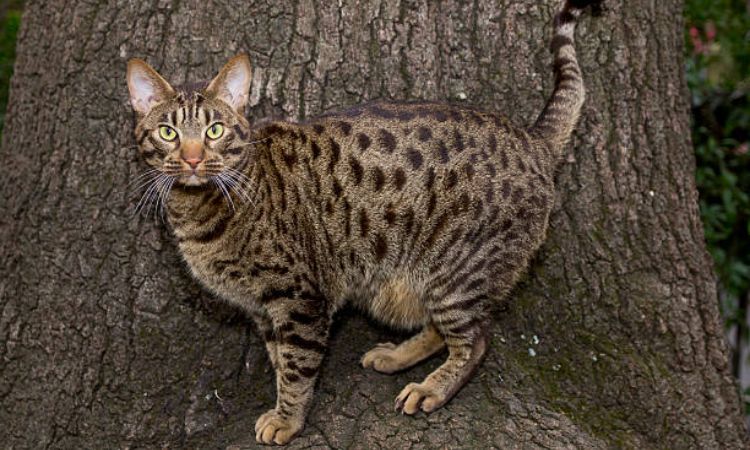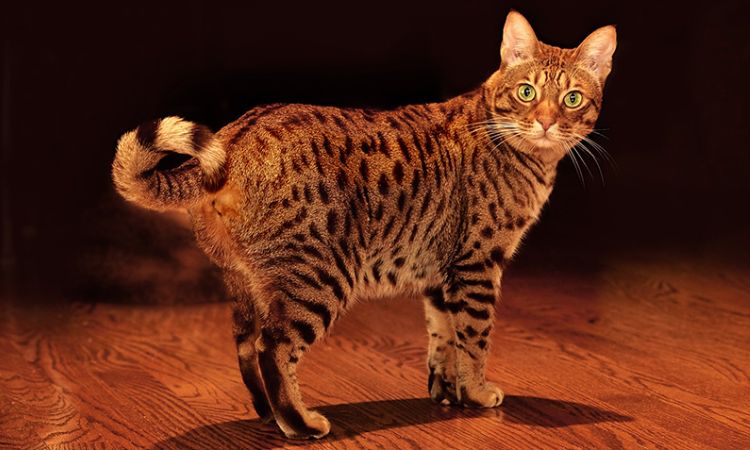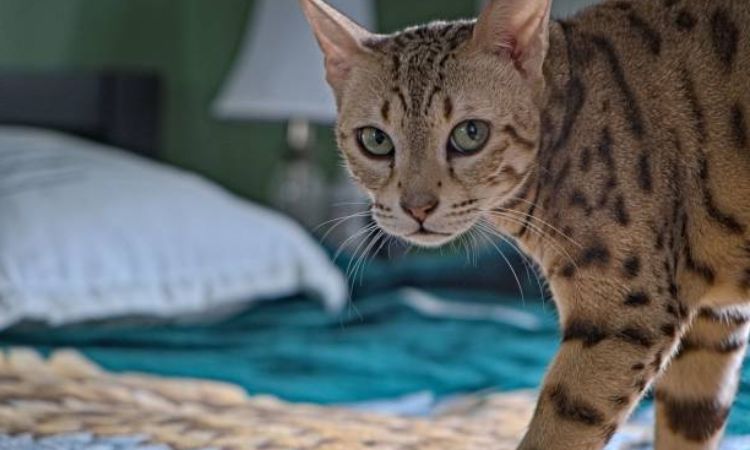The Ocicat is a domestic cat with a strikingly wild appearance, yet it has no recent wild ancestry. Its sleek, athletic body and distinctive spotted coat make it look like it belongs in the jungle, but its personality is entirely that of a loving, playful companion.
Curious, intelligent, and full of energy, Ocicats are known for their dog-like loyalty, following their favorite people around the house and joining in on family activities. This captivating blend of exotic looks and devoted temperament makes the Ocicat a truly unique feline.

Ocicat Size and Appearance
The Ocicat is a domestic breed that radiates a wild, exotic look without any recent wild ancestry. Its combination of muscular build, sleek coat, and bold markings gives it the striking appearance of a miniature jungle cat, yet it remains entirely domesticated.
Body and Build
Ocicats are medium to large cats, with males generally larger than females. They weigh between 6 and 15 pounds and have an athletic, muscular frame that often feels heavier than expected. Their height ranges from 9 to 11 inches, and they can reach up to 24 inches in length from nose to tail tip. Strong legs, well-balanced proportions, and an agile body make them excellent jumpers and climbers, giving them a confident, graceful stance.
The Signature Spotted Coat
The Ocicat’s short, sleek coat is easy to maintain yet visually dramatic. The breed’s hallmark is its spot-tabby pattern, with thumbprint-sized spots scattered across the body, and a distinct bullseye pattern often appearing on the flanks of show-quality cats. Large spots may also appear on the shoulders, hindquarters, and legs. Ocicats come in 12 recognized colors, including Tawny, Blue, Chocolate, Cinnamon, Fawn, Lilac, and their corresponding silver variations, offering a wide spectrum of coat options that enhance the breed’s wild appearance.
Head and Features
Ocicats have a wedge-shaped head with a broad, defined muzzle, giving a poised, alert look. Their large ears are set at roughly a 45-degree angle and occasionally have small tufts. Almond-shaped eyes are wide-set and can be any color except blue, with green and gold being most common. These features, combined with the breed’s spotted coat, give the Ocicat its signature exotic yet domesticated appearance.
Ocicat Personality and Temperament
Ocicats are often described as a “dog in a cat’s body” — outgoing, affectionate, and highly interactive. Unlike more independent cat breeds, they thrive on social interaction and enjoy being involved in everything their human companions are doing. They are confident, curious, and intelligent, which makes them quick learners who can be trained to fetch, walk on a leash, respond to voice commands, and even perform tricks.
These cats are energetic but not hyperactive, balancing playful bursts with periods of calm snuggling. They love mental stimulation, so toys, puzzles, and interactive play are essential to keep them happy. Ocicats are also known for their vocal nature, often communicating their needs or expressing excitement, though they are not typically obnoxious about it.
Friendly and sociable, Ocicats get along well with other cats, dogs, and even children, making them an excellent choice for busy, active households. They do best in environments where they aren’t left alone for long periods, as boredom can lead to mischief. With the right attention, Ocicats become loyal, playful, and affectionate companions who bring energy, charm, and personality to any home.
Ocicat Facts, Care, and Health

Key Facts About Ocicats
- Origin: United States
- Size: Medium to medium-large; 6–15 pounds
- Height/Length: 9–11 inches tall, up to 24 inches long
- Coat: Short, dense, and sleek
- Coat Colors: Tawny, cinnamon, chocolate, fawn, blue, lilac, and silver variations
- Coat Pattern: Distinctive spots over tabby stripes
- Eyes: Almond-shaped; gold or green (breed standard excludes blue)
- Lifespan: 12–18 years
- Hypoallergenic: No
- Personality Traits: Affectionate, social, highly intelligent, playful, vocal
Ocicats are often described as “dogs in cat fur” due to their loyalty, social nature, and eagerness to interact with humans. They thrive in active households, enjoy playtime, and form strong bonds with their family members.
Ocicat Care
Grooming
Ocicats have short, low-maintenance coats that require minimal grooming. Weekly brushing with a soft or rubber brush removes loose hair, distributes natural oils, and provides bonding time. They are not heavy shedders, and their skin is typically healthy and non-oily.
- Eyes: Monitor for signs of irritation, infection, or changes in vision.
- Ears: Inspect regularly for discharge, odor, or signs of mites; cleaning is rarely required unless recommended by a vet.
- Nails: Trim regularly and provide scratching posts or pads to maintain healthy claws.
Exercise and Enrichment
Highly active and athletic, Ocicats need daily physical and mental stimulation:
- Interactive play sessions with toys, feather wands, or balls
- Climbing on cat trees, shelves, or perches
- Puzzle feeders and slow feeders for mental engagement
- Training sessions using clickers or treats
Ocicats enjoy safe outdoor exploration with a harness and leash but should not be allowed to roam freely.
Diet and Nutrition
A species-appropriate diet is essential for Ocicats’ muscular and energetic bodies.
- Kittens: Require high-protein, nutrient-rich food for growth
- Adults: Balanced diet to maintain weight and muscle tone
- Seniors: May benefit from age-specific diets to support joint and kidney health
Feeding strategies:
- Timed meals: Helps control portions and monitor intake
- Free-feeding: Convenient but may lead to overeating
- Enrichment feeders: Encourage mental stimulation while eating
Consult a veterinarian before adding supplements or making major diet changes.
Ocicat Health
Ocicats are generally healthy but may inherit certain conditions from their parent breeds:
- Amyloidosis: Abnormal protein deposits affecting kidneys or liver, potentially leading to organ failure
- Hypertrophic Cardiomyopathy (HCM): Thickening of the heart wall that can impair cardiac function
- Periodontal Disease: Gum and dental problems common in cats; early intervention is key
- Pyruvate Kinase (PK) Deficiency: Rare blood disorder causing anemia
- Progressive Retinal Atrophy (PRA): Genetic eye condition leading to vision loss over time
Regular veterinary checkups, a balanced diet, and exercise help ensure a long and healthy life, with many Ocicats living 12–18 years.

Considerations for Pet Owners
- Require time and attention for play, training, and social interaction
- Benefit from climbing spaces, scratching posts, and enrichment toys
- Not ideal for owners seeking a low-energy, independent cat
- Often do best with another pet companion for stimulation
The Ocicat combines a striking, wild appearance with a playful, social, and intelligent nature. Its athletic build, distinctive spotted coat, and affectionate personality make it a unique companion for active households, while proper care, enrichment, and attention ensure a healthy, happy life.






